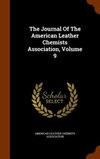Anti-Ectoparasite Activity of Medicinal Herbal Plant in Terms of Reducing Ectoparasites Effect on Sheep and Goat Skins
IF 0.5
4区 工程技术
Q4 CHEMISTRY, APPLIED
Journal of The American Leather Chemists Association
Pub Date : 2023-11-01
DOI:10.34314/jalca.v118i11.8240
引用次数: 0
Abstract
Ethiopia has one of the world’s largest livestock resources. However, the effects of disease, inadequate nutrition and management constrain the potential of this resource. Ectoparasites are one of the primary contributing factors in the tanneries for sheep and goat skin rejection. The aim of this study is to assess the impact of medicinal herbal plant extracts on ectoparasites (ticks) on small ruminants in Ethiopia. According to scientific and ethnomedical data gathered from respondents (farmers), the plant species P. dodecandra, E. globulus, C. macrostachyus, J. schimperiana, and C. aurea were used (by farmers) for the study. Phytochemical screening of extracts revealed the presence of flavonoids, alkaloids, phenols and saponins, tannins. Ticks from small ruminants (i.e goat and sheep) were collected and an in vitro adult tick immersion test was carried out using concentrations of 6.25, 12.5, 25, 50, and 100 mg/ml of all medicinal plant extracts. The temporal tick mortality was observed within 24-hours. In order to compare the results, distilled water and 12.5% amitraz was used as positive and negative controls, respectively. After 24 hours of exposure, P. dodecandra, J. schimperiana, and C. macrostachyus extracts had a moderate (60%) effect on tick mortality; however, C. aurea extract at 100 mg/ml and E. globulus extract at 50 mg/ml and 100 mg/ml had the highest mortality rate (80%). The study found that following in vitro treatment for the studied plants, the mean tick mortality increased considerably with increasing concentration and exposure duration. The existence of phytochemicals (active ingredients) in several plants, such as phenols, flavonoids, alkaloids, tannin, saponin, etc., may be the cause of their anti-ectoparasite effects. The study’s findings suggested that these plants might be crucial in reducing the need for chemical based medicines as well as managing the population of resistant ticks in an environmentally friendly manner.药用草本植物在减少绵羊和山羊皮外寄生虫影响方面的抗外寄生虫活性
埃塞俄比亚拥有世界上最大的牲畜资源之一。然而,疾病、营养不足和管理不善限制了这一资源的潜力。体外寄生虫是导致绵羊和山羊皮制革厂拒收的主要因素之一。本研究旨在评估药用植物提取物对埃塞俄比亚小型反刍动物体外寄生虫(蜱虫)的影响。根据从受访者(农民)处收集到的科学和民族医学数据,本研究(农民)使用了 P. dodecandra、E. globulus、C. macrostachyus、J. schimperiana 和 C. aurea 等植物物种。对提取物进行的植物化学筛选显示,其中含有黄酮类、生物碱、酚类、皂苷和单宁酸。收集小反刍动物(即山羊和绵羊)身上的蜱虫,使用浓度为 6.25、12.5、25、50 和 100 毫克/毫升的所有药用植物提取物进行体外成蜱浸泡试验。在 24 小时内观察到暂时性蜱死亡。为了比较结果,分别使用蒸馏水和 12.5% 的双甲脒作为阳性对照和阴性对照。接触 24 小时后,P. dodecandra、J. schimperiana 和 C. macrostachyus 提取物对蜱虫死亡率的影响适中(60%);但 C. aurea 提取物(100 毫克/毫升)和 E. globulus 提取物(50 毫克/毫升和 100 毫克/毫升)的死亡率最高(80%)。研究发现,在对所研究的植物进行体外处理后,随着浓度和暴露时间的增加,蜱的平均死亡率大幅上升。几种植物中存在的植物化学物质(活性成分),如酚类、黄酮类、生物碱、单宁、皂苷等,可能是它们具有抗外来寄生虫作用的原因。研究结果表明,这些植物对于减少对化学药物的需求以及以环保的方式管理抗药性蜱虫的数量至关重要。
本文章由计算机程序翻译,如有差异,请以英文原文为准。
求助全文
约1分钟内获得全文
求助全文
来源期刊

Journal of The American Leather Chemists Association
工程技术-材料科学:纺织
CiteScore
1.30
自引率
33.30%
发文量
29
审稿时长
3 months
期刊介绍:
The Journal of the American Leather Chemists Association publishes manuscripts on all aspects of leather science, engineering, technology, and economics, and will consider related subjects that address concerns of the industry. Examples: hide/skin quality or utilization, leather production methods/equipment, tanning materials/leather chemicals, new and improved leathers, collagen studies, leather by-products, impacts of changes in leather products industries, process efficiency, sustainability, regulatory, safety, environmental, tannery waste management and industry economics.
 求助内容:
求助内容: 应助结果提醒方式:
应助结果提醒方式:


